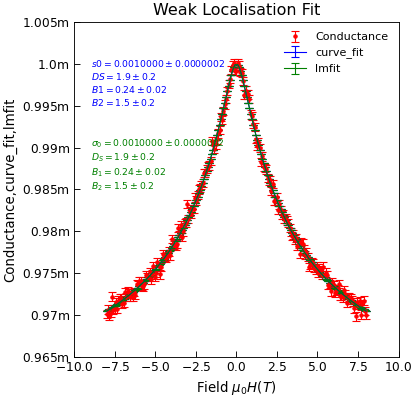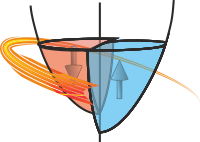wlfit¶
- Stoner.analysis.fitting.models.e_transport.wlfit(B, s0, DS, B1, B2)[source]¶
Implement the Weak localisation fitting function.
- Parameters:
B (array) – mag. field
s0 (float) – zero field conductance
DS (float) – scaling parameter
B1 (float) – elastic characteristic field (B1)
B2 (float) – inelastic characteristic field (B2)
- Returns:
Conductance vs Field for a weak localisation system
Notes
2D WL model as per Wu et al PRL 98, 136801 (2007), Porter et al PRB 86, 064423 (2012)
Example
"""Test Weak-localisation fitting.""" from copy import copy from numpy import linspace, ones_like from numpy.random import normal from Stoner import Data from Stoner.analysis.fitting.models.e_transport import WLfit, wlfit B = linspace(-8, 8, 201) params = [1e-3, 2.0, 0.25, 1.4] G = wlfit(B, *params) + normal(size=len(B), scale=5e-7) dG = ones_like(B) * 5e-7 d = Data( B, G, dG, setas="xye", column_headers=["Field $\\mu_0H (T)$", "Conductance", "dConductance"], ) d.curve_fit(wlfit, p0=copy(params), result=True, header="curve_fit") d.setas = "xye" d.lmfit(WLfit, result=True, header="lmfit") d.setas = "xyeyy" d.plot(fmt=["r.", "b-", "g-"]) d.annotate_fit( wlfit, x=0.05, y=0.75, fontdict={"size": "x-small", "color": "blue"} ) d.annotate_fit( WLfit, x=0.05, y=0.5, fontdict={"size": "x-small", "color": "green"}, prefix="WLfit", ) d.title = "Weak Localisation Fit"

